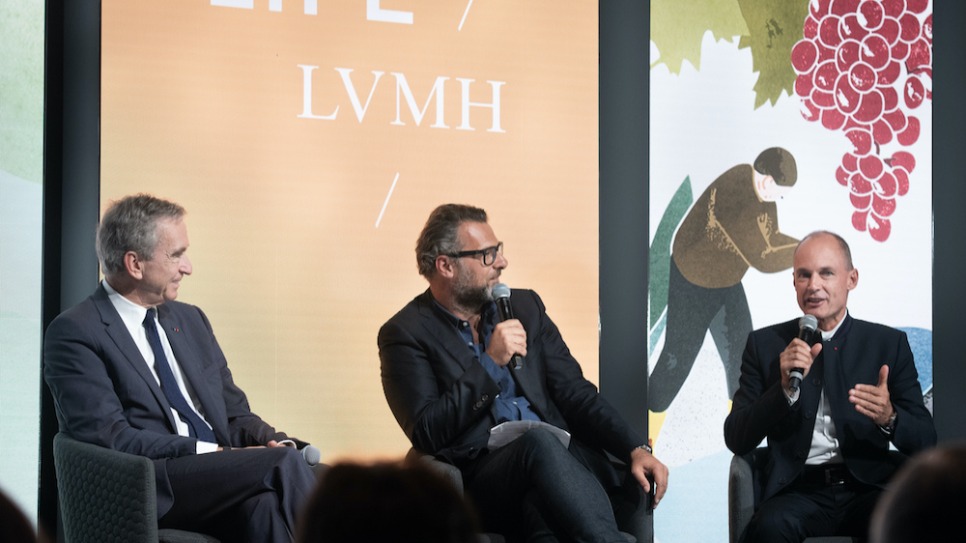News - September 27, 2019
LVMH and the Solar Impulse Foundation to find solutions for sustainable luxury


Written by Tristan Lebleu 3 min read
The partnership between the two entities is part of a global effort from the world’s biggest luxury goods company to put protection of the environment at the core of its priorities, without compromising on financial results.
“We prefer acts to pacts” proclaimed Antoine Arnault, LVMH, as he introduced the Future Life Paris event on September 25th at the group’s headquarters in Paris, focused on the LIFE Program - LVMH Initiatives For the Environment program.
In a series of keynotes and panel discussions, LVMH Chairman and Chief Executive, Bernard Arnault, along with the Group’s Sustainability Director, Sylvie Bénard, and executives from LVMH highlighted the concrete actions taken by each of the Group’s Maisons to increase their environmental performance, such as reduction of energy consumption, incorporation of circular economy principles, protection of biodiversity, and eco-design.
These concrete actions include a strategic partnership between LVMH and the Solar Impulse Foundation, announced on stage by Bernard Arnault, Chairman and CEO of LVMH and Bertrand Piccard, Chairman of the Solar Impulse Foundation. The partnership aims to find innovative and efficient clean technologies to combat environmental issues. Applying a co-development approach, the Solar Impulse Foundation will provide LVMH’s and its Maisons’ teams and partners with certified solutions. LVMH, on the other end, will certify innovations that are already implemented within the Group among the Foundation’s pool of 1,000 solutions. The field of work will include, among other areas, energy consumption in the boutiques of the Group’s Maisons, the production of proprietary renewable energy, and the use of alternative ways of transport to air freight.
“The relationship with LVMH dates back to the Solar Impulse adventure around the world, and it’s fantastic to witness LVMH’s ambition to continue on their path toward sustainability. Luxury goods companies can have a very positive impact deep into their supply chains, by requesting that their products are provided in a more environmentally friendly manner, using resources more efficiently, and with reduced waste”
Bertrand Piccard, Chairman of the Solar Impulse Foundation
The event was an opportunity for LVMH to present its progress on the four 2020 environmental objectives defined in 2012 as part of its LIFE Program: improve the environmental performance of all its products, apply the highest standards for sourcing, improve key environmental performance indicators for all sites, and reduce CO2 emissions.
“Our results speak for themselves,” said Bernard Arnault during the event. The business leader has been a pioneer in incorporating sustainability in the Group, making environmental policy a strategic pillar to drive growth back in 1992. And the results are nothing less but spectacular:
- Renewable energy: With renewable energy representing already 27% in LVMH’s energy mix in 2018, the 2020 target of 30% is likely to be exceeded.
- CO2 emissions: Rather than choosing compensation, LVMH first wants to reduce its CO2 emissions. The Group is on track to meet the target of reducing its CO2 emissions by 25% by 2020. The CO2 emissions decreased by 16% between 2013 and 2018 in spite of considerable sales growth over that same period. This result was in part due to a reduction of 16% of energy consumption by square meter in the Group’s stores, driven by an increased use of LED lighting.
- LVMH Carbon Fund: LVMH’s Carbon Fund doubled the price per metric ton of CO2 generated from 15 to 30 euros in 2018, thus further accelerating initiatives to reduce CO2 emissions. The funds are not used as offsets but to directly finance CO2-reducing projects in the Group’s Maisons: 112 projects were financed in 2018.
- Waste management: 91% of waste was reused, recycled or transformed into energy in 2018.
- Responsible leather sourcing: Today, 48% of the leather used by LVMH’s Maisons is sourced in Leather Working Group (LWG) certified tanneries, ensuring that the best environmental practices are implemented. The target of 70% will be achieved by the end of 2019. LVMH tanneries are already LWG certified.
- Precious stones: LVMH has already achieved 99% of its 100% objective for Responsible Jewelry Council certification of diamonds used by 2020.
Along with these results, the evening was an opportunity for executives of LVMH’s Maisons to share concrete examples of how sustainability is incorporated in every aspect of the Group’s activities. Michael Burke, CEO and Chairman of Louis Vuitton, explained how the famous luxury company participated in the repopulation of American alligators through sustainable farming, while the animal was on the verge of extinction. Laurent Boillot, CEO and Chairman of Guerlain, shared his commitment to protect bees through education and sustainable sourcing, as the insect is crucial to the beauty company’s products. Another example came from the CEO of Sephora, Christopher de Lapuente, who has started replacing the 5 million light bulbs in 2600 Sephora stores by LED lights and all delivery trucks by electrics vehicles, reducing the company’s CO2 emissions by 25%.
As a conclusion, Toni Belloni, the Group Managing Director, reminded the audience that LVMH had succeeded in reducing its CO2 emissions by 16%, while at the same time increasing its sales. This is an example for the business community, and perfectly illustrates a core message of Bertrand Piccard and the Solar Impulse Foundation: that ecology goes hand in hand with economy and that protection of the environment is profitable. The corporate world is now fully recognizing that a thriving nature and environment are crucial for the long-term prosperity of businesses.

Written by Tristan Lebleu on September 27, 2019
